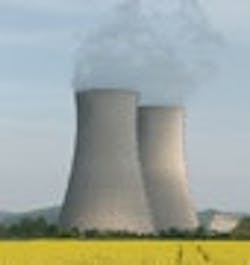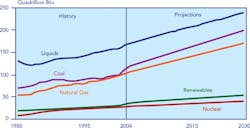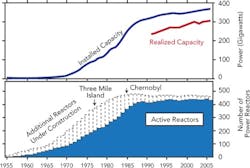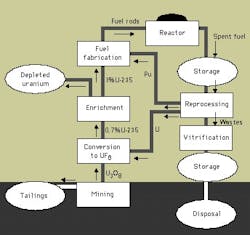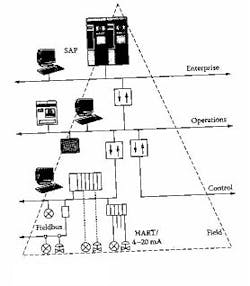The Future of Nuclear Energy
This article was printed in CONTROL's March 2009 edition.
Last November, I described the first cyber terrorism incident on a nuclear power plant through the Internet ("Nuclear Plant Security and Cyber Terrorism"). In January, I explained the operation of the fission and fusion processes ("Nuclear Security, Part II—Fission Basics"). In this article, I will focus on the present and future trends in this industry and on the role which process control should play in making it safer.
The advantage of using nuclear energy is that it has no “carbon footprint,” and it does not cause climate change. Its disadvantages involve the unsafe nature of the process and the exhaustibility of its fuel (uranium). The availability of this fuel depends on the price of uranium, because the profitability of mining depends on it. Today this price is around $50/lb (U3O8) and based on that, the amount that can be profitably recovered is estimated at three to four million tons. If the price rises to $100/lb, this global reserve will rise to about four to five million tons. As the yearly consumption is about 77,000 tons, even at $100/lb, this reserve will be sufficient only for about 65 years, a reserves-to-production (R/P) ratio of 65. This is less than the R/P ratio for coal and only about 50% more than oil or natural gas.
While the fuel for today’s thermal fission reactors is uranium, the fuel of breeder reactors is plutonium 239. The main concern about breeders is that plutonium can be used directly (without further concentration) to build “dirty” nuclear bombs, while uranium requires sophisticated concentration before it can be used in a weapon. Therefore, in this discussion I will not even consider breeders. Similarly, I will not consider fusion reactors, because they operate at millions of degrees temperature; hence, I consider them unpractical.
Today, nuclear energy supplies 7.5% of the total global energy consumption (Figure 1), corresponding to about 17% of the global (20% of the U.S.) electricity consumption.
Figure 1. Global (marketed) energy use between 1980 and projected to 2030.
Source: www.eia.doe.gov/iea.
Nuclear Industry Trends
The nuclear industry is only 50 years old. The first nuclear power plant was built in the Soviet Union in 1954. Since that time, some 575 nuclear power plants have been built, including 125 in the United States (Figure 2). As of 2008, the installed capacity of all the operating plants in the world was 413 GW (119 GW in the United States), while their actual electricity production rate was about 300 GW (~ 100 GW in the United States), giving an average availability for nuclear power plants of 73% (85%-90% in the United States).
Figure 2. History of the use of nuclear power (top) and the number of active nuclear power plants (bottom).
source: www.globalwarmingart.com/wiki/
Of the 575 plants built, 439 are still in operation, 119 have been shut down, but of these, only 17 has been decommissioned, because decommissioning is complicated and expensive. As to new ones, three were started up in 2007 and as of this writing, 35 are under construction. Some countries, such as Germany and Spain, are committed to phasing out nuclear power completely; others are building new ones. In France, 59 nuclear plants are in operation, and 11 are being decommissioned. Ukraine, Finland and other countries are building new ones.
Figure 3: The complete nuclear energy generation process
In the United States, between 1970 and 1980, all applications to build new nuclear power plants—some 100—were turned down. Of the already-built nuclear power plants, 13 have been permanently shut down, and 10 have completed their decommissioning (operating license terminated). To minimize the risk of radiation, the decommissioned plants are still either guarded or are entombed in concrete.
Decommissioning takes a lot of time and money. For example the Trojan plant in Rainier, Ore., was built in 1972 and was shut down in 1993, yet it took until 2006 to complete its decommissioning, and the radioactive wastes it has generated while in operation are still stored at the site.
As of 2000, the total investment to build the over 500 nuclear power plants was about $2.5 trillion ($0.65 trillion in the United States). As to the positive impact of nuclear plants on carbon emission, a study by Princeton scientists determined that if the global carbon emission was to be cut by only 15% by 2050 through the increased use of nuclear power, 1,070 plants would need to be built, and this would cost $5 trillion. (To appreciate the size of this cost: The global GWP is around $45 trillion; the American GDP is about $15 trillion; the U.S. debt is around $35 trillion; total federal debt about $12 trillion; the foreign holdings of treasury securities is about $4 trillion; and the present federal budget is about $3 trillion.)
The Safety of the Processing Steps
The processes used in the nuclear power industry start with mining. The safety record of mining, enrichment and fuel fabrication is fairly good.
Automation Pyramid
While nuclear fuel preparation is relatively safe, it is not accident-free. For example, in May 2008, the world’s largest uranium producer’s (Cameco) Port Hope plant in Ottawa was shut down because of concerns about radioactive leakage into Lake Ontario.
Most nuclear accidents (over 100) occurred in the nuclear reactors themselves. The majority of these accidents were caused by design or operator errors involving either the fuel rod or the coolant controls. Radiation leaks can also occur because of earthquakes, ageing, poor waste storage practices or terrorist attacks. The most important safety goal is to maintain the proper operation of the reactor cooling systems. Therefore, redundancy and backup of controls and equipment is more important than in other industrial operations, because here the run-away conditions evolve quickly, while plant shutdown is slow and complicated. (An example of such events occurred in August 2007, when the cooling tower of the Vermont Yankee plant collapsed).
Another potential cause of accidents is ageing and the trend to replace or duplicate the hardwired analog controls with digital systems. Safety can also be reduced when data highways are installed on top of or in parallel with the original analog controls. The evolution of these ”hybrid” control systems in many plants resulted in several layers of poorly documented and poorly understood controls.
Despite a thriving global computer security industry, the Internet remains insecure. Because even the most heavily garrisoned military networks have proved vulnerably, permitting ANY form of Internet-based communication between the Operations and Enterprise levels of a nuclear power plant is an unacceptable risk.
